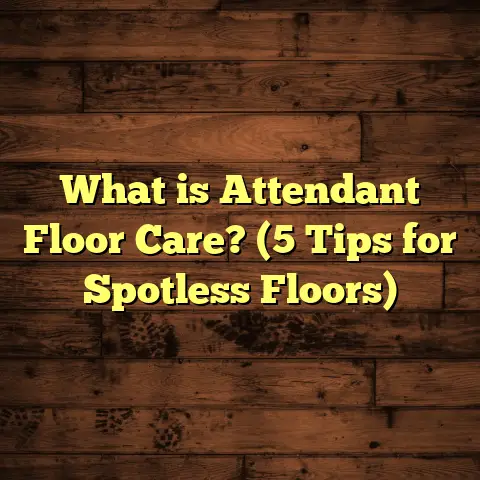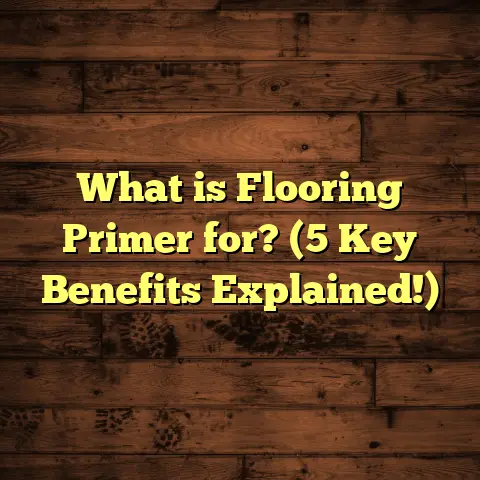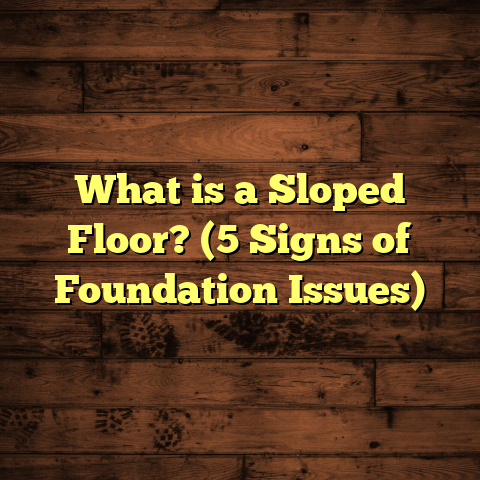What is a Linear Foot for Flooring? (5 Key Tips for Saving)
I remember when I first decided to renovate my home’s flooring. It was one of those projects I thought would be straightforward but quickly became a rabbit hole of measurements, cost estimates, and material choices. One thing that kept coming up in every conversation with suppliers, contractors, and even friends was “linear foot.” What exactly is a linear foot, and why does it matter so much in flooring projects? If you’ve been scratching your head about this term or wondering how to use it effectively to save money and avoid mistakes, I totally get it. Over the years, working both in residential flooring and consulting for commercial projects, I’ve learned how understanding linear footage can be a game-changer. Let me share what a linear foot really means for flooring and five key tips that helped me save thousands on projects big and small.
What Is a Linear Foot for Flooring?
At its core, a linear foot is a simple measurement: it’s one foot of length along a straight line. The key word here is length. Unlike square footage, which measures area (length times width), linear footage only looks at length. This matters a lot in flooring because different materials are priced and sold based on different measurements.
Imagine you’re buying baseboards for your room. You don’t buy them by how much floor area they cover; instead, you buy them by how long the baseboard needs to run along the walls. If your room is 12 feet by 15 feet, the perimeter is: (12+15)×2=54 feet(12 + 15) \times 2 = 54 \text{ feet}
This means you need baseboards that total 54 linear feet. That’s it—width and thickness don’t factor into this calculation.
Linear Feet vs Square Feet: Why It’s More Than Just Semantics
Sometimes people confuse linear feet with square feet because both involve “feet.” But they serve very different purposes in flooring.
- Square Footage measures area. You multiply length by width to get the total space you need to cover. Flooring materials like hardwood planks, laminate sheets, vinyl tiles, or carpet are usually sold by the square foot because they cover space.
- Linear Footage measures length only. It’s used for materials that are installed along edges or lines—like baseboards, crown molding, stair nosing, or threshold strips.
This distinction is crucial because buying the wrong amount of material can blow your budget or cause delays.
Why Flooring Suppliers and Contractors Talk About Linear Feet
In my early days as a flooring contractor, this distinction wasn’t obvious to many clients. I’d have homeowners tell me they needed “10 square feet” of baseboard when they really meant 10 linear feet. This led to ordering way too little or way too much material.
Baseboards typically come in standard lengths—8-foot or 12-foot pieces are common. If you miscalculate the total linear footage required, you’ll either run short during installation or waste money on excess stock.
Plus, labor costs for installing these materials frequently depend on linear footage rather than square footage. A carpenter might charge $2 per linear foot to install baseboards but charge differently for flooring installation based on area.
Measuring Linear Feet Properly: What I Learned From Experience
Early in my career, I worked on a project in Portland where the homeowner wanted oak baseboards around a sunroom. The room was oddly shaped with several nooks and bay windows.
I showed them how to measure each wall segment individually and add them up for total linear feet instead of guessing based on square footage. We ended up with 96 linear feet of baseboards.
Ordering exactly that amount saved us from extra trips to the supplier and kept labor efficient since we had all materials upfront. The project finished two days ahead of schedule because we avoided material shortages.
How Much Does Flooring Material Cost Per Linear Foot?
Costs vary widely by material type and region, but here’s a rough idea based on my experience across different U.S. locations:
- Basic MDF baseboards: $1.50 – $3 per linear foot
- Pine or softwood baseboards: $2 – $4 per linear foot
- Hardwood (oak, maple) trims: $5 – $10 per linear foot
- Decorative crown molding: $6 – $12 per linear foot
Labor usually adds about $1 to $3 per linear foot for installation of trims and moldings.
For example, I worked on a home in Atlanta where oak baseboards ran about $7 per linear foot including labor. For a 75-foot perimeter room, the cost was roughly: 75 ft×$7/ft=$52575 \text{ ft} \times \$7/\text{ft} = \$525
In contrast, a simpler MDF baseboard with labor might only be $2 per linear foot total, saving hundreds but with less durability and aesthetic appeal.
5 Key Tips I Use to Save Money Using Linear Foot Calculations in Flooring
1. Measure Carefully—Add Waste Margins
One of my biggest early mistakes was underestimating how much trim or baseboard material was needed due to incorrect measurements or forgetting waste margins.
Here’s what I do now:
- Measure each wall segment separately.
- Add measurements for inside corners, door casings, and any architectural features.
- Add about 5-10% extra material for waste due to cutting mistakes or fitting around corners.
In a kitchen remodel I did last year in Chicago, this approach helped me avoid ordering extra materials twice. The kitchen perimeter was about 48 feet; adding 10% waste meant ordering about 53 linear feet of trim. This small buffer saved me from delays caused by needing extra pieces after cutting errors.
2. Know When to Apply Linear Feet vs Square Feet
It sounds obvious but can be confusing if you’re new to flooring projects.
I often explain to clients:
- Flooring planks (hardwood, laminate) are sold by square feet because they cover surface area.
- Baseboards, moldings, stair nose strips are sold by linear feet because they cover length along edges.
Using tools like FloorTally has made this easier for me recently. I input room dimensions and select materials; the tool calculates both square footage for flooring and linear footage for trims automatically—no guesswork or manual conversion needed.
3. Bulk Buying Saves Money—but Only With Proper Calculations
Bulk purchasing can save money if you know exactly how much material you need.
Once I calculated the exact linear footage for trim on a client’s house in Dallas, we ordered everything in one go rather than multiple small batches.
For example:
- Baseboards come in 8-foot lengths.
- You need 56 linear feet total.
- That means ordering seven full 8-foot pieces (56 ÷ 8 = 7).
This avoids buying 6 pieces and then having to order one more later because you ran short.
4. Factor Labor Costs Based on Linear Feet
When budgeting labor for baseboard or molding installation, contractors usually charge per linear foot.
For example:
- Installing MDF baseboards might cost $1-$2 per linear foot.
- Hardwood or decorative trim installation can be $3-$5 per linear foot depending on complexity.
Knowing your exact linear footage helps avoid surprises in labor costs.
In one project in Boston, I initially underestimated labor by guessing baseboard length without measuring corners correctly. The final bill was $300 higher than expected because installers had to spend extra time cutting and fitting unexpected angles.
5. Use Technology Like FloorTally to Keep Estimates Accurate
FloorTally has become a go-to tool for me when estimating projects. It lets me enter room lengths and widths and select flooring types; then it calculates both square feet (for flooring) and linear feet (for trims) with waste factors included.
It also uses local pricing data for materials and labor so estimates are realistic.
In a recent commercial project in Miami installing vinyl sheet flooring with cove base molding around offices, FloorTally helped me manage both materials on one platform instead of juggling spreadsheets and multiple supplier quotes.
Detailed Insights From My Flooring Projects Around the U.S.
Case Study 1: Hardwood Installation and Linear Foot Missteps in Seattle
A client wanted premium oak hardwood floors with matching oak baseboards in their 2,000 square-foot home.
We measured the floor area for hardwood planks easily—just length times width of each room added together—but the baseboards were trickier due to multiple interior walls with doorways.
Initially, they estimated needing 150 linear feet of baseboard based on rough measurements but we found the actual total was closer to 185 linear feet after detailed measuring using laser distance tools.
The difference of 35 linear feet cost an additional $350 just in materials plus installation time.
Lesson learned: always measure carefully with proper tools before ordering materials priced by linear feet!
Case Study 2: Commercial Vinyl Flooring & Trims in Phoenix
At an office building renovation I oversaw, vinyl sheet flooring was installed on about 8,000 square feet of floor space.
Cove base molding (a type of wall trim) was installed around all rooms to protect walls from damage and create clean edges.
The cove base came in rolls measured by linear feet. The total perimeter was roughly 1,200 linear feet across hallways and offices combined.
By using detailed blueprints and digital measurement tools combined with FloorTally estimates, we ordered exactly what was needed—including a 7% waste margin—and avoided costly overruns or delays.
What About Complex Spaces? Measuring Linear Feet Gets Tricky
Not all rooms are nice rectangles. Curved walls, bay windows, staircases, and open layouts complicate measurements but still rely on accurate linear footage calculations for trims and moldings.
I once helped a client in San Francisco with an older Victorian home filled with curved archways and intricate trim work. We used flexible tape measures and laser distance meters to capture exact lengths along curves because baseboards had to be custom cut and bent to fit perfectly.
This extra effort upfront saved weeks during installation because no surprises came up needing last-minute orders or adjustments.
How Regional Factors Affect Linear Foot Costs and Timing
From my years working across states like Georgia, Colorado, New York, Texas, Oregon, and Florida:
- Material costs vary: Shipping hardwood trims to remote areas adds freight charges making prices rise by as much as 30%.
- Labor rates change: Metropolitan areas usually have higher labor costs ($3-$5 per linear foot) compared to rural towns ($1-$2 per linear foot).
- Availability impacts timing: Some specialty trims require custom orders from suppliers with lead times up to 3 weeks depending on location.
Keeping these factors in mind helps when budgeting or planning project schedules involving linear foot-based materials.
Personal Story: How Understanding Linear Feet Saved Me Thousands
Before I understood the importance of precise linear foot measurements, I once bought trim material for my own home renovation blindly estimating wall lengths based on rough guesses.
Long story short—I underbought by nearly 20%, causing multiple supplier trips and delaying installation by almost a week.
That experience motivated me to invest in measurement tools like laser distance meters and adopt software tools like FloorTally that handle complicated calculations instantly.
Since then, every project I manage runs smoother with tighter budgets and fewer surprises—saving clients (and myself) thousands over time.
Breaking Down Costs: How Linear Feet Impact Your Flooring Budget
Let’s talk numbers to make this real:
Suppose you have a living room that measures:
- Length: 20 feet
- Width: 15 feet
Your floor area is: 20×15=300 sq ft20 \times 15 = 300 \text{ sq ft}
You want hardwood flooring priced at $6 per square foot (including materials but excluding labor). Your baseboards will run around the perimeter: (20+15)×2=70 linear feet(20 + 15) \times 2 = 70 \text{ linear feet}
Assuming baseboards cost $5 per linear foot including installation:
- Flooring cost: 300×$6=$1,800300 \times \$6 = \$1{,}800
- Baseboard cost: 70×$5=$35070 \times \$5 = \$350
Total basic materials + installation cost = $2,150
If you miscalculate baseboards by even 15 feet (say you only ordered for 55 feet), that’s an unexpected extra cost: 15×$5=$7515 \times \$5 = \$75
Not huge here but this adds up quickly across multiple rooms or larger homes.
FAQs About Linear Footage in Flooring Projects
Q: Can I convert square footage to linear footage?
A: Not directly because they measure different things. You can calculate perimeter (linear feet) if you know room dimensions but converting area (square feet) into length without width info isn’t possible accurately.
Q: How much extra should I order beyond my calculated linear footage?
A: Typically between 5% and 10% more for waste depending on cuts needed and complexity of installation.
Q: Do all types of trim use standard lengths?
A: Most trims come in standard lengths like 8-foot or 12-foot pieces but specialty trims may vary; always check supplier specs before ordering.
Q: How do I measure curved walls?
A: Use flexible measuring tapes or laser measuring devices designed for curved surfaces; sometimes professional measurement is best if shapes are complex.
Final Advice Before You Start Your Flooring Project
Understanding what a linear foot means in flooring isn’t just jargon—it affects your entire budgeting process from buying materials through hiring labor to completing installation on time.
Here’s my quick checklist before ordering any trim or molding:
- Measure every wall segment precisely.
- Include doors/windows where trim applies.
- Add waste allowance.
- Confirm standard lengths from supplier.
- Calculate number of pieces needed based on linear footage.
- Factor labor costs per linear foot.
- Use digital tools like FloorTally or laser measurement apps.
- Consult your contractor if unsure about complex layouts.
These steps have saved me countless headaches—and thousands of dollars—in every project since I adopted them seriously.
If you want me to share more personal stories about particular projects that taught me important lessons about measuring linear feet or discuss how specific tools have changed my workflow dramatically over time, just ask! Flooring can seem complicated at first but breaking it down step-by-step makes it manageable—and even enjoyable—to plan well and save money effectively.
Would you like me to include more detailed case studies from specific cities or expand on technology options beyond FloorTally? Or perhaps talk about integrating these measurements into overall home renovation budgets? Let me know!





